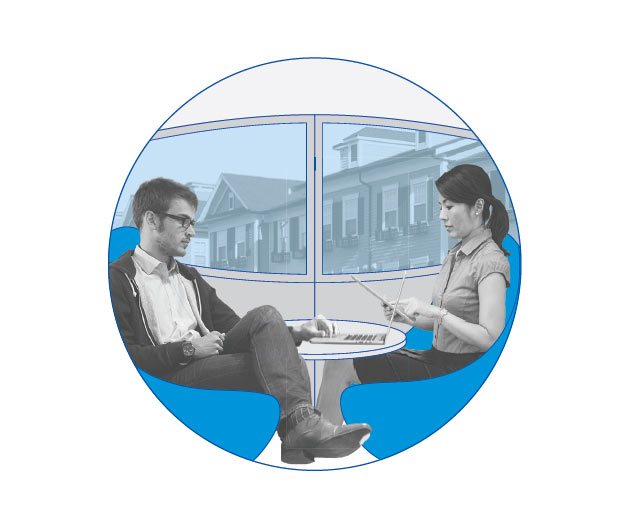#Transport2050: UBC’s AnnaLisa Meyboom on apps, autonomous vehicles, and reimagined roads
#Transport2050: UBC’s AnnaLisa Meyboom on apps, autonomous vehicles, and reimagined roads


We’ve asked thought leaders to share their vision for the future of transportation. What do you see? Shape the future of how we move and live. Visit transport2050.ca
By: AnnaLisa Meyboom, Assistant Professor, UBC Clean Energy Research Centre and author, Driverless Urban Futures
Transportation is key to accessing jobs, services and to increasing general productivity – less time wasted getting places. New technologies have the potential to get everyone where they need to go more conveniently. The term “everyone” is also important – our societal goal should be to provide access and ease of transportation to all ages, abilities and incomes. This will strengthen our social fabric as well as our economy.
What technologies are coming that could enable this?
Mobility as a Service

Mobility as a Service (MaaS) brings all means of travel together: one app to route and pay for your trip all in one place, whatever the mode. It makes trip planning and payment easier, and could increase the convenience and usefulness for transit, bike share, car share, or other modes of transportation. This could support healthier lifestyle choices, greater sustainability, and new ways of looking at existing transportation services.
Autonomous vehicles and public transportation

Autonomous vehicles are another future technology which will revolutionize how we move around. They have the potential to address many of the challenging aspects of public transit. For example, on-demand shuttles or shared autonomous vehicles could ferry people between their homes and transit stations.
Service at night could be maintained with on-demand systems providing better safety and service for those who need to travel during later hours. Transit systems could adjust service in real-time to meet demand and deploy more vehicles as needed; advanced booking systems could even reserve seats so riders do not have to stand. An agile and responsive system could allow for smaller vehicles and reduced wait times. These changes would revolutionize public transit and, by providing faster and more responsive services, could help attract more riders.
Reimagining road space

While demand for road space could decrease with mobility as a service or autonomous vehicles, other emerging modes, such as electric bikes or kickboards, could place new demand for urban space. Even now, we face difficulties in managing space for all road users.
We will need to take part of the street to facilitate emerging transportation modes rather than have them compete for sidewalk or bicycle lane space.
Looking at the future of transportation, perhaps the best way of organizing streets is not by mode, but by speed. Meaning specific lanes for pedestrians and vehicles of three different speeds: slow (e.g. bikes), medium (e.g. light electric vehicles) and fast (full speed automobiles/trucks). In our region this may mean planning lanes for new modes of transportation.
The content presented here is meant to promote discussion and are the personal reflections of the writer. This information does not represent the views or opinions of TransLink.







PGSLOT, a free spinning wheel website, we are ready to give unlimited From the story of signing up, come spin the wheel for free every hour to receive scatter bonuses.
We challenge everyone to try and experience it. with a new gambling experience That guarantees that it’s cool and not lose anyone for sure.
which manages the system in a punch Can’t play with the system bouncing problem. Deposits and withdrawals are definitely unsuccessful.
SLOT WALLET Free Gaming credit bonus 200% from around the world สล็อตแตกง่าย
It is recommended to select the minimum first. Then aim and shoot the fish that swim into the screen and press to shoot the desired fish.
It is a path to make free money without investment at all. Continue to enjoy the game until the free credits run out, withdraw the money you get into your wallet. This is a real money game. No investment that players have to come to know.
instant updates are gathered in one group. without having to wait for board time or share as specified by the website know now tell now sometimes
You can try every game without depositing first. In addition, there are also many promotions. Waiting to provide full value for 24 hours without having to waste time making turns.
To allow players to access more profits You will enjoy playing slots in every camp. without having to switch users There is only one True Money app.
want to join online group for free to update news and information about online slot games What do you have to do without trending? Let’s see how to join a free line group, get a free line group link with us now.
is a website that has been guaranteed by real users that can easily make a profit with the highest payback rate Rest assured that all your bets will definitely be profitable
Come to redeem hundreds of free bonuses. Go to play slots and make more profits than before.
Our website bonuses are easy to break. Get real money. You can choose to play slots games to your satisfaction. and also supports playing through all forms of online platforms.
SLOT WALLET, a new vertical slot game. Modern with beautiful graphics great effect Supports playing on all platforms Whether it’s a computer
until we believe it is true and let it happen automatically. Happiness takes place in our own hearts. which makes us work happily all day long.
including free credit that does not require depositing, does not need to be shared, can be easily picked up by yourself, can be called a single bet, complete all services
play slots today, get 50 free credits, no deposit required, very easy to receive via automatic system no matter what device you play It’s fun without interruption The minimum bet starts at 1 baht only.
a selection of popular slot games. All of our slot games are fun and fun games for members to play through the main pg website, PGSLOT slots that have a safe standard.
Slot Promotion with very special payout rates for all types of betting games Whether you choose to play slot games or any betting game on our website
Thai Wallet website, open to play unlimited minimum slots. So don’t have to worry that there is little capital will not be able to play. Because no matter how much capital can be a millionaire overnight
that every formula selected to give away We have carefully selected And will be able to help you make more bonuses for sure.
Play through PGWALLET, the most dazzling web wallet. that serves but the most premium service Enjoy making money uniquely.
pg deposit 19 get 100 Let you use only ten digits. Come to redeem hundreds of free bonuses. Go play slots and make more profits than before.
A collection of premium services It is the rich channel of the year 2022 that guarantees that there are the most PG games to choose from. Play the game smoothly and without interruption. no matter what device you play
to please the members But how to get bonus from pro slots It has a new format. Make it easier to access through as well. You can claim the bonus through free credit code that is easy to accept on mobile
all the services that are selected to offer They all put their value in full. If you want to know how to play and receive the largest bonus, apply for membership, click here.
SLOT WALLET website, a new game betting website which is coming strong overtaking the curve It is a website with clear statistics. That the most players in 2022 enter the web wallet Confident in giving away bonuses in full,
Play with the web, we are 100% confident that you will only play quality games. that provide services according to international standards only
Guarantees that you will get to the story about slots faster than before. Including various playing formulas that are useful in betting will be sent from the master to your hand for free every day Don’t be afraid to be difficult to enter. And don’t be afraid of any costs
PGWALLET, the leader in slot game system. that combines leading Come to play all in one website. Applicants are guaranteed not to be disappointed.
The PGSLOT website is well designed and serviced. for all gamblers get full of happiness No matter how many times I play, I’m still impressed with pg
that it’s a million percent safe. We have a free slots trial mode available which you can access without depositing a single baht first.
Genuine direct website, no minimum, PGWALLET slots, free credit 200, just apply and get full, no deduction. Increase capital, play slots, get great profits
PG bonus slots are the easiest to break. That should be a word that many players hear regularly. We are the web pro slots that dare to give the most.
matter how little time You can easily own hundreds of thousands of bonuses because of all the games offered. famous for cracking in a few spins only
The minimum deposit is only 1 baht, you can play PG games and make a profit for the whole camp.
new members, deposit 10, receive 100 wallets. Slot Promotion with very special payout rates for all types of betting games Whether you choose to play slot games or any betting game on our website
convenient withdrawals every day. Let’s go beyond the traditional deposit and withdrawal transactions with the most popular website, direct wallet website, right now.
no need to share, give away from the start of application. Without having to deposit before, you can click to receive via the web page by yourself.
get overflowing bonus for every game, what kind of game does he choose? We dare to give out techniques without vests.
You can apply for membership to choose to play games with efficiency. without worrying about security through pg wallet, the big website, every day
How to play new slots games that will help you win the bonus you want. in a timely manner is to try to play repeatedly until you understand the payout pattern.
thank you for this useful informations amd i found something is interesting here mega game please visit my webside
Play online slots for easy money. http://www.megagame-888.com/
Free online slots demo. http://www.megagame-888.com
Water: Staying hydrated is crucial for good health. Water is essential for digestion, circulation, and temperature regulation. Aim to drink plenty of water throughout the day.
สมัครเว็บบอล
Herbs and Spices: Many herbs and spices not only add flavor to your dishes but also offer potential health benefits. For example, turmeric has anti-inflammatory properties, and garlic may support heart health.
สมัครเว็บบอล
อัพเดทช่องทางเข้าเล่นเงินจริงเล่นง่ายผ่านมือถือที่รองรับทุกระบบทั้ง IOS & ANDROID https://lavaslot88.co/ มีเกมสล็อตในค่ายให้เลือกมากกว่า 5,000 เกมที่ระบบยอมรับได้ และเข้าใจความหมายอื่นๆ เทียบกับค่ายอื่นๆ มีแจ็คพอตสำหรับทั้งรางวัลเล็ก และใหญ่ที่รับรองว่าเจ้าของได้กำไรอย่างแน่นอน
เว็บสล็อตสุดฮอดตอันดับ 1 เล่นเลยวันนี่มีโปรเด็ดๆ ให้เลือกมากมาย pglava slot มีเกมให้เลือกเล่นมากมาย เช่น เกมปลาเกมสล็อตและเกมอื่นๆ เกมโจ๊กจัดให้อย่างที่ต้องการเพื่อให้ยิงได้สนุกสุดๆ โบนัสแตกบ่อย
เกมคาสิโนดีที่สุดในการเล่นเกมคาสิโนกับเพื่อนของเรา rachaslot มีเกมให้เลือกเดิมพันมากมาย อัพเดทเกมใหม่ๆ อยู่เสมอ ไม่พลาดทุกกระแสเกมฮิต บริการฝาก-ถอนระบบออโต้ด้วยตัวเองง่ายๆ
สล็อตระบบใหม่ล่าสุด 2023 สมัครง่าย โบนัสแตกง่าย ฝาก-ถอน เร็วสุด ๆ ผ่านระบบออโต้ สล็อต ทุนฟรี 50 เว็บไซต์ให้บริการเดิมพันออนไลน์ สล็อตแตกง่าย คาสิโน บาคาร่าสด วิดีโอเกมสล็อตออนไลน์สุดมันส์ รวมทุกค่าย เล่นได้บนเว็บไซต์ เล่นเกมสล็อตออนไลน์ได้ทุกค่าย
เกมสล็อต ออนไลน์ จากค่าย คาสิโน ออนไลน์ มีเกมให้เลือกเล่นมากมายบนเว็บของเรา ครบวงจรที่สุดและพบกับเกมที่รวบรวมจากค่ายเกมจะได้รับอย่างเกมจากค่าย PGSLOT ค่าย SLOTXO ค่าย JOKER สามารถแข่งขัน บน เว็บเดิมพัน 100%